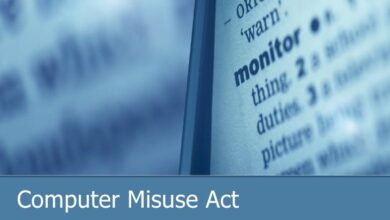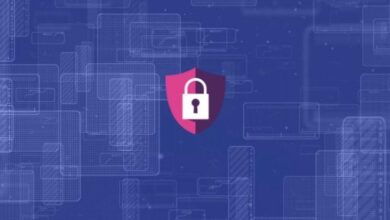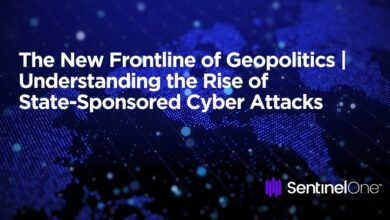
US Ports Cybersecurity Bidens Top Priority
Us ports cybersecurity now a top priority for joe biden – US ports cybersecurity is now a top priority for Joe Biden, and for good reason. Our nation’s ports are critical infrastructure, the arteries of our economy, handling trillions of dollars in goods annually. A successful cyberattack could cripple supply chains, disrupt trade, and even threaten national security. This isn’t just about protecting data; it’s about safeguarding our way of life.
Biden’s administration is taking significant steps to bolster defenses, but the challenge is immense, requiring a multi-pronged approach involving technology, collaboration, and a skilled workforce.
The Biden administration’s focus stems from a growing awareness of the vulnerabilities inherent in our port systems. Outdated infrastructure, a lack of standardized security protocols, and the increasing sophistication of cyber threats create a perfect storm. This post will explore the specific threats, the administration’s response, and the crucial steps needed to secure our ports for the future.
We’ll delve into the technological solutions, the importance of information sharing, and the need for a highly trained cybersecurity workforce dedicated to protecting these vital gateways.
Biden Administration’s Focus on US Port Cybersecurity
The Biden administration has significantly elevated the importance of cybersecurity for US ports, recognizing their critical role in the nation’s economy and national security. The interconnected nature of modern port operations, coupled with the increasing sophistication of cyber threats, necessitates a proactive and comprehensive approach to safeguarding these vital infrastructure hubs. This heightened focus isn’t merely a reactive measure; it’s a strategic shift towards a more resilient and secure maritime sector.The rationale behind this prioritization is multifaceted.
US ports handle a massive volume of goods, representing a significant portion of the nation’s GDP. A successful cyberattack could disrupt supply chains, causing widespread economic damage and potentially impacting national security. Furthermore, ports are increasingly reliant on interconnected digital systems controlling everything from cargo handling and vessel traffic management to access control and security systems. A breach in these systems could have devastating consequences, potentially leading to physical damage, theft, or even terrorism.
The administration recognizes that a robust cybersecurity framework is crucial to mitigating these risks.
Executive Orders and Policy Initiatives
Several executive orders and policy initiatives underscore the Biden administration’s commitment to enhancing cybersecurity at US ports. While specific details of some initiatives might be classified for national security reasons, the overall direction is clear. The administration has emphasized the need for improved information sharing between government agencies, port authorities, and private sector stakeholders. This collaborative approach aims to create a more holistic and effective cybersecurity ecosystem.
Furthermore, there’s a strong push for the adoption of advanced cybersecurity technologies and best practices, including threat intelligence sharing, vulnerability assessments, and incident response planning. Investment in cybersecurity infrastructure upgrades is also a key component of this strategy, along with enhanced training and awareness programs for port personnel. The administration has also stressed the importance of developing and implementing clear cybersecurity standards and regulations for port operations.
Comparison with Other Major Global Port Nations
While precise comparisons of cybersecurity measures across different nations are difficult due to the sensitive nature of this information, general observations can be made. Many major global port nations are also prioritizing cybersecurity improvements, recognizing the shared challenges and risks. However, the US approach, characterized by its emphasis on public-private partnerships and a holistic, multi-agency approach, stands out.
The scale of US port operations and its integrated role in global supply chains necessitates a more comprehensive and coordinated strategy than what might be sufficient for smaller or less interconnected port systems in other countries. While specific details of other nations’ cybersecurity frameworks are often kept confidential, the general trend points towards a global recognition of the critical need to protect port infrastructure from cyber threats.
The US, however, is arguably at the forefront of developing a robust and comprehensive national-level strategy in this area.
Cybersecurity Threats Facing US Ports
The increasing reliance on digital systems within US ports presents a significant vulnerability to cyberattacks. These attacks can range from relatively minor disruptions to catastrophic failures with far-reaching consequences for the economy, national security, and public safety. Understanding the nature of these threats is crucial for developing effective mitigation strategies.The interconnected nature of modern port operations, coupled with the volume of sensitive data handled, makes them prime targets for malicious actors.
These actors can be state-sponsored groups, organized crime syndicates, or even lone individuals motivated by various agendas. The potential impact of a successful cyberattack underscores the urgent need for robust cybersecurity measures.
Ransomware Attacks, Data Breaches, and Denial-of-Service Attacks
Ransomware attacks represent a significant threat to US ports. These attacks involve encrypting critical systems, rendering them unusable until a ransom is paid. A successful ransomware attack could cripple port operations, halting the flow of goods and causing significant economic losses. Data breaches, on the other hand, involve the unauthorized access and theft of sensitive information, including trade secrets, customer data, and employee details.
Such breaches can lead to financial losses, reputational damage, and legal liabilities. Denial-of-service (DoS) attacks aim to overwhelm port systems with traffic, rendering them unavailable to legitimate users. This can disrupt operations, delaying shipments and impacting the supply chain. For example, a DoS attack targeting a port’s container tracking system could cause significant delays and logistical nightmares.
The consequences of such attacks extend beyond immediate operational disruptions, potentially impacting international trade relations and national security.
Consequences of a Successful Cyberattack on a US Port
A successful cyberattack on a US port could have devastating consequences across multiple sectors. Economically, the disruption of port operations would lead to significant losses for businesses relying on the port for shipping and receiving goods. The ripple effect could impact entire supply chains, leading to shortages and price increases for consumers. From a national security perspective, a compromised port could be used to smuggle contraband or disrupt critical infrastructure.
This could involve the theft of sensitive cargo or the introduction of harmful materials into the supply chain. Public safety is also at risk, as a cyberattack could disrupt emergency response systems or compromise critical infrastructure, such as power grids or communication networks. Imagine a scenario where a cyberattack disables the port’s emergency communication systems during a severe weather event; the consequences could be catastrophic.
The Role of Human Error and Insider Threats
Human error plays a significant role in port cybersecurity vulnerabilities. Phishing scams, weak passwords, and a lack of awareness about cybersecurity best practices can all create entry points for malicious actors. Insider threats, involving employees or contractors with malicious intent, also pose a serious risk. These individuals may have legitimate access to sensitive systems and data, making them particularly dangerous.
For example, a disgruntled employee with access to port security systems could potentially cause significant damage. Therefore, robust employee training programs, strong access control measures, and regular security audits are essential for mitigating these risks. The implementation of multi-factor authentication and regular security awareness training can significantly reduce the likelihood of successful attacks stemming from human error and insider threats.
Technological Solutions for Enhanced Port Security
The Biden administration’s prioritization of US port cybersecurity necessitates a robust technological framework. This framework must go beyond traditional security measures and leverage cutting-edge technologies to effectively mitigate the evolving threat landscape. A multi-layered approach, integrating advanced analytics and automation, is crucial for ensuring the resilience and security of our nation’s ports.
A comprehensive cybersecurity framework for US ports requires a holistic approach, integrating advanced technologies to address vulnerabilities across the entire port ecosystem. This includes physical infrastructure, operational technology (OT), information technology (IT), and the human element. By combining these technologies strategically, ports can achieve a significant leap in their security posture.
A Cybersecurity Framework for US Ports
Implementing a comprehensive cybersecurity framework for US ports requires a layered approach, combining preventative, detective, and responsive measures. The framework should encompass asset inventory and vulnerability management, threat intelligence gathering and analysis, security information and event management (SIEM), and incident response planning. Critically, it must integrate advanced technologies like AI, machine learning, and blockchain to enhance efficiency and effectiveness.
AI and machine learning can be used for predictive analysis, identifying potential threats before they materialize, while blockchain can enhance data integrity and transparency across the supply chain.
Specific Cybersecurity Technologies for US Ports
Several specific cybersecurity technologies are well-suited for implementation in US ports. The following table Artikels some key technologies, their functionalities, benefits, and potential implementation challenges:
| Technology | Function | Benefit | Implementation Challenges |
|---|---|---|---|
| AI-powered Intrusion Detection System (IDS) | Analyzes network traffic and identifies malicious activity in real-time, flagging anomalies and potential threats. | Reduces false positives, improves detection accuracy, and enables proactive threat mitigation. | Requires significant data for training, potential for bias in algorithms, and ongoing maintenance and updates. |
| Machine Learning-based Predictive Maintenance | Predicts potential equipment failures and security vulnerabilities based on historical data and sensor readings. | Minimizes downtime, reduces maintenance costs, and proactively addresses potential security risks. | Requires integration with various systems, data quality issues, and the need for specialized expertise. |
| Blockchain for Supply Chain Security | Creates a tamper-proof record of goods movement, enhancing transparency and traceability throughout the supply chain. | Reduces the risk of counterfeit goods and improves the ability to track and trace potentially compromised shipments. | Integration with existing systems, scalability challenges, and the need for widespread adoption across the supply chain. |
| Multi-Factor Authentication (MFA) | Requires multiple forms of authentication to verify user identity, enhancing access control and reducing unauthorized access. | Stronger security against credential theft and unauthorized access. | Potential for user inconvenience and the need for robust user training. |
| Network Segmentation | Divides the network into smaller, isolated segments, limiting the impact of a security breach. | Contains the spread of malware and reduces the overall attack surface. | Increased complexity in network management and potential performance impact. |
Examples of Successful Cybersecurity Implementations in Other Industries
Several industries have successfully implemented advanced cybersecurity technologies that can be adapted for use in US ports. For example, the financial services industry’s use of robust authentication methods, including biometric verification and tokenization, could be leveraged to secure access control within port facilities. Similarly, the energy sector’s implementation of advanced threat detection systems based on AI and machine learning could be adapted to monitor and protect critical port infrastructure.
The healthcare industry’s experience with data encryption and secure data storage provides valuable lessons for protecting sensitive port data, including cargo manifests and personnel information. Adapting these best practices and integrating them into a comprehensive cybersecurity framework will significantly enhance the security posture of US ports.
Collaboration and Information Sharing

Securing America’s ports requires a unified front. The sheer complexity of the modern port ecosystem, encompassing diverse stakeholders and intricate technological systems, necessitates a collaborative approach to cybersecurity. Effective information sharing is not just beneficial; it’s absolutely critical for mitigating the escalating cyber threats targeting our ports. A fragmented approach leaves vulnerabilities exploitable by malicious actors.The interconnected nature of port operations means a breach at one point can cascade throughout the entire system.
A successful attack on a single terminal’s network, for example, could disrupt the entire supply chain, causing significant economic losses and potentially jeopardizing national security. Therefore, a comprehensive strategy built on strong collaboration and seamless information sharing is paramount.
A Multi-Agency Collaborative Framework
Effective port cybersecurity demands a structured framework for collaboration. This framework should involve the coordinated efforts of several key players: government agencies (like the Cybersecurity and Infrastructure Security Agency (CISA), the Transportation Security Administration (TSA), and the Coast Guard), port authorities, private sector companies (shipping lines, terminal operators, technology providers), and independent cybersecurity experts. Clear lines of communication and defined roles and responsibilities are essential for this framework to function optimally.
For instance, CISA could provide overarching cybersecurity guidance and threat intelligence, while TSA focuses on physical security measures that complement cyber defenses. Port authorities would be responsible for implementing security measures within their jurisdictions, and private companies would contribute their expertise and resources to enhance the overall security posture.
Establishing Effective Information Sharing Mechanisms
A robust information-sharing system is the backbone of any successful collaborative effort. This system should facilitate the timely dissemination of threat intelligence, vulnerability information, and best practices among all stakeholders. This could involve establishing a secure, centralized platform for information exchange, potentially leveraging existing government-industry information sharing and analysis centers (ISACs) and similar initiatives. Regular meetings, workshops, and joint exercises could further enhance communication and collaboration.
The system should be designed to handle sensitive information securely, adhering to strict privacy and confidentiality protocols. For example, anonymized threat data could be shared to protect sensitive business information while still providing valuable insights into emerging threats.
Improved Communication Protocols for Enhanced Threat Mitigation
Standardized communication protocols are vital for efficient and effective response to cyber threats. This includes establishing clear incident reporting procedures, ensuring consistent terminology and data formats, and developing standardized communication channels for real-time threat alerts and coordinated responses. A well-defined escalation path for handling incidents, from initial detection to remediation and recovery, is also crucial. For example, a standardized incident reporting form could ensure that all relevant information is captured and shared consistently across agencies and organizations.
Regular cybersecurity drills and simulations can test the effectiveness of these protocols and identify areas for improvement. The goal is to create a system where threats are identified quickly, responses are coordinated seamlessly, and damage is minimized.
Training and Workforce Development

Protecting our nation’s ports requires a robust cybersecurity strategy, and a crucial element of that strategy is a highly trained and skilled workforce. Investing in comprehensive training programs is not just beneficial; it’s essential for mitigating the ever-evolving threats facing our port infrastructure. A well-trained workforce is the first line of defense against cyberattacks, capable of identifying threats, responding effectively to incidents, and ultimately ensuring the continued safe and efficient operation of our ports.The need for specialized cybersecurity training for port workers is paramount.
Current port personnel, while skilled in their respective areas, often lack the specific knowledge and skills to effectively address the complexities of modern cyber threats. This knowledge gap leaves our ports vulnerable to sophisticated attacks that could disrupt operations, compromise sensitive data, and even threaten national security. Developing a skilled cybersecurity workforce requires a multi-pronged approach, incorporating both initial training and ongoing professional development.
This isn’t simply about reacting to threats; it’s about proactively building a resilient and secure system.
Cybersecurity Awareness Training for Port Personnel, Us ports cybersecurity now a top priority for joe biden
A comprehensive cybersecurity awareness training program should be implemented for all port personnel, regardless of their specific role. This training should cover a range of topics, including recognizing phishing attempts, understanding social engineering tactics, and identifying malware. Practical exercises and simulations should be included to reinforce learning and develop practical skills. For example, employees could participate in simulated phishing attacks to learn how to identify and report suspicious emails.
Regular refresher courses would ensure that employees stay updated on the latest threats and best practices. The training should also emphasize the importance of reporting any suspicious activity immediately. A clear and easily accessible reporting mechanism should be established, and employees should be encouraged to report even minor incidents.
Specialized Cybersecurity Training for Port Workers
Beyond general awareness training, specialized cybersecurity training is crucial for specific roles within the port environment. IT personnel, for example, require advanced training in network security, incident response, and vulnerability management. Security personnel need training in physical security measures, access control, and surveillance technologies, with an emphasis on integrating these with cybersecurity protocols. Operations personnel should receive training on the cybersecurity implications of their daily tasks, such as handling sensitive data or using port automation systems.
This specialized training should be tailored to the specific job responsibilities and risk profiles of each role. For example, training for IT staff might include hands-on experience with intrusion detection systems, while training for operations personnel might focus on secure operational procedures.
Cybersecurity Certifications and Professional Development
Establishing industry-recognized cybersecurity certifications and professional development opportunities would significantly enhance the credibility and skills of port security personnel. These certifications could demonstrate a commitment to professional excellence and provide a benchmark for assessing competence. The development of career pathways within port cybersecurity, with opportunities for advancement and specialization, would attract and retain talented individuals. This could include specialized certifications in areas such as network security, incident response, or physical security.
With US port cybersecurity now a top priority for President Biden, securing our critical infrastructure is paramount. Efficient, secure application development is key, and that’s where advancements like those discussed in this article on domino app dev the low code and pro code future become incredibly relevant. Streamlining development processes could help bolster defenses against cyber threats targeting our ports, ensuring a faster response to vulnerabilities.
Furthermore, ongoing professional development opportunities, such as workshops, conferences, and online courses, would help port personnel stay abreast of the latest threats and technologies. This continuous learning approach is crucial in the ever-evolving landscape of cybersecurity. The establishment of a mentorship program pairing experienced cybersecurity professionals with newer employees could further accelerate skill development and knowledge transfer.
International Cooperation on Port Cybersecurity
International cooperation is crucial for effectively safeguarding global port infrastructure from increasingly sophisticated cyberattacks. The interconnected nature of global trade means a successful attack on one port can have ripple effects across the entire supply chain, impacting economies and national security worldwide. Different nations approach port cybersecurity with varying levels of emphasis and resources, leading to a patchwork of defenses that can be exploited by malicious actors.
Understanding these differences and fostering collaboration are key to building a more resilient and secure global port system.The cybersecurity strategies employed by different countries to protect their ports vary significantly, reflecting differences in technological capabilities, regulatory frameworks, and national priorities. Some nations, like the United States, have invested heavily in developing comprehensive national cybersecurity strategies that specifically address critical infrastructure, including ports.
These strategies often involve a multi-agency approach, combining efforts from government bodies, private sector companies, and academic institutions. Other nations may have a more centralized approach, with a single government agency responsible for overseeing port cybersecurity. The level of private sector involvement also varies considerably, with some countries relying heavily on private companies to implement and maintain security systems, while others take a more hands-on approach.
This disparity in approaches creates challenges for international cooperation, as different systems and standards may not be easily compatible.
Comparative Analysis of National Port Cybersecurity Strategies
A comparison of national strategies reveals a spectrum of approaches. For instance, the EU’s Network and Information Security Directive (NIS Directive) mandates cybersecurity measures for operators of essential services, including ports, while individual member states have their own specific regulations and enforcement mechanisms. In contrast, some developing nations may lack the resources or expertise to implement sophisticated cybersecurity measures, relying instead on basic security practices and international assistance.
This disparity in resources and capabilities underscores the need for tailored international support and capacity building initiatives. Furthermore, the focus of national strategies also varies. Some prioritize the protection of physical infrastructure, while others place greater emphasis on the security of information systems and data. A holistic approach that integrates both physical and cyber security is essential for comprehensive port protection.
Potential Areas for International Collaboration
Several key areas offer significant potential for enhanced international collaboration in countering transnational cyber threats targeting ports. Sharing threat intelligence is paramount. A coordinated system for exchanging information on emerging cyber threats, vulnerabilities, and attack patterns would allow ports worldwide to proactively mitigate risks. Developing common cybersecurity standards and best practices would streamline security efforts and ensure interoperability between different port systems.
Joint cybersecurity exercises and training programs could improve preparedness and response capabilities. Furthermore, international cooperation in areas such as law enforcement and judicial cooperation is crucial for tracking down and prosecuting cybercriminals targeting ports. The establishment of a global port cybersecurity task force, comprising representatives from various nations and organizations, could significantly improve coordination and collaboration efforts.
Recommendations for Strengthening International Cooperation
Strengthening international cooperation in port cybersecurity requires a multi-pronged approach. Firstly, the establishment of a global forum for port cybersecurity could facilitate regular dialogue and information sharing between nations. This forum could serve as a platform for discussing best practices, coordinating responses to cyber incidents, and developing common standards. Secondly, targeted capacity building initiatives are essential to assist developing nations in improving their cybersecurity capabilities.
This could involve providing technical assistance, training programs, and financial support. Thirdly, international agreements and legal frameworks are needed to address the jurisdictional challenges posed by transnational cybercrime. These agreements could establish clear responsibilities and mechanisms for cooperation in investigating and prosecuting cyberattacks targeting ports. Finally, promoting public-private partnerships is essential. Collaboration between governments, port authorities, and private sector companies is crucial for sharing information, developing innovative security solutions, and ensuring the implementation of effective cybersecurity measures across the entire port ecosystem.
Budgetary Considerations and Resource Allocation
Securing America’s ports requires a significant financial commitment. The sheer scale of infrastructure, the complexity of interconnected systems, and the evolving nature of cyber threats demand a robust and adaptable cybersecurity budget. This isn’t just about immediate costs; it’s a strategic investment in long-term economic stability and national security.The necessary financial resources for comprehensive port cybersecurity measures are substantial and multifaceted.
This includes funding for advanced technologies like intrusion detection systems, threat intelligence platforms, and robust data encryption solutions. Furthermore, significant investment is needed in personnel training, ongoing system maintenance, and the development of emergency response plans. Costs will vary significantly depending on the size and technological sophistication of individual ports, but a phased approach with clearly defined priorities is crucial.
We can look to the investments made in airport security post-9/11 as a relevant example of the scale of resources potentially required, albeit adapted to the digital landscape.
Funding Sources and Allocation Strategies
Effective resource allocation requires a clear understanding of priorities and a well-defined strategy. A multi-year plan, outlining specific investments and anticipated returns, is essential. Funding sources could include federal grants specifically earmarked for port cybersecurity, increased port authority budgets, and potentially, public-private partnerships. Allocating funds based on a comprehensive risk assessment, prioritizing ports with the highest vulnerability and economic impact, is crucial for maximizing the effectiveness of the investment.
A robust cost-benefit analysis should underpin all decisions.
Cost-Benefit Analysis in Port Cybersecurity
Cost-benefit analyses (CBA) are essential for justifying cybersecurity investments. These analyses should quantify both the costs of implementing security measures (hardware, software, personnel, training) and the potential costs of cyberattacks (financial losses, operational disruptions, reputational damage, potential for physical harm). A well-constructed CBA will weigh the cost of prevention against the potential cost of an incident, demonstrating the long-term financial advantages of proactive cybersecurity measures.
For example, the cost of implementing a robust intrusion detection system might seem high initially, but it pales in comparison to the potential millions of dollars in losses from a successful ransomware attack that could cripple port operations.
Prioritizing Cybersecurity Investments for Long-Term Savings
Prioritizing cybersecurity investments directly translates to long-term cost savings. Proactive measures, such as regular security audits, employee training programs, and the implementation of advanced threat detection systems, significantly reduce the likelihood of successful cyberattacks. The cost of remediating a cyberattack, including investigation, recovery, and legal fees, can far exceed the cost of preventative measures. Moreover, the reputational damage and loss of public trust following a major cyberattack can have devastating long-term economic consequences.
Investing in robust cybersecurity now is an investment in avoiding far greater costs later. The 2017 NotPetya ransomware attack, which caused billions of dollars in damage globally, serves as a stark reminder of the potential financial devastation of a large-scale cyber incident. Investing in robust preventative measures would have been far less costly in the long run.
Closure
Securing US ports against cyber threats is a complex, ongoing endeavor, demanding a unified front. While President Biden’s prioritization marks a crucial step, the long-term success hinges on consistent investment in technology, robust collaboration between public and private sectors, and a dedicated, highly trained cybersecurity workforce. The stakes are high, but the potential rewards – a resilient and secure supply chain – are even greater.
The journey towards a truly secure port system will require ongoing vigilance, adaptation, and a commitment to innovation, but the ultimate goal – safeguarding our national interests and economic well-being – is worth the effort.
Expert Answers: Us Ports Cybersecurity Now A Top Priority For Joe Biden
What specific types of ransomware are most commonly targeting US ports?
While specific strains aren’t always publicly disclosed for security reasons, ransomware targeting industrial control systems (ICS) and operational technology (OT) are a significant concern, as they can directly disrupt port operations.
How are other countries addressing port cybersecurity?
Many nations are implementing similar initiatives, focusing on international collaboration, technology upgrades, and workforce training. However, the level of investment and sophistication varies significantly.
What role does the private sector play in port cybersecurity?
Private companies operating within and around ports are crucial. They hold valuable data and operate critical systems, making their cooperation in security initiatives essential.
What is the potential impact of a successful cyberattack on public trust?
A major cyberattack could severely erode public trust in the security of the supply chain and the government’s ability to protect critical infrastructure.





